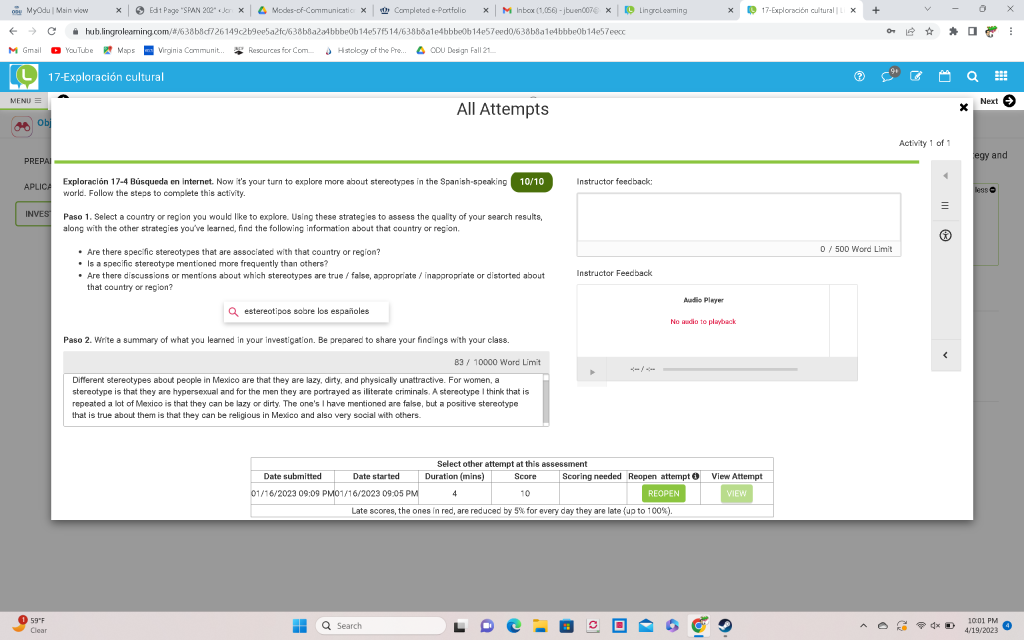Interpretive, Interpersonal, and Presentational Modes of Communication
In class we would practice speaking with other classmates in Spanish talking about a variety of topics. We would also speak in front of the class with whatever it was we discussed with our other classmates and present it all in Spanish. Reading and writing in Spanish was a big activity we would do in the class. We would answer questions that were written in Spanish then write them down in the same language then present them to the class.
Artifacts


Exploring Culture
We always worked on Cultural activities on LingroLearning. In the assignments, the class would have to do research on a Spanish-Speaking country of their choosing and answer the questions that are provided to them. We would have to also compare and contrast different cultures from other countries that speak Spanish.
Engaging in Communities
A way of us engaging in our community would be using what we have learned in the classroom and practice it with other Spanish speaking individuals. We would also engage with our classmates and reflect on what we have learned or help answer the questions in Spanish.
These activities were always helpful since it can help the student learn the language and practice speaking to other people who speak Spanish. It was good practice to put in too. It can help prepare the students for the next topic or assignment they will be given in Spanish. It can also help them come up with questions to ask their instructor with anything they have trouble with such as conjugations or knowing what a new word means.
Interpersonal Communication
Besides engaging with our communities in Spanish, whether that would be engaging with someone who speaks Spanish or practicing speaking the language with their classmates, we would do two TalkAbroad assignments. In these two assignments, we would speak with a Spanish speaking person from another Spanish speaking country for about 15 minutes.
I personally enjoyed these assignments speaking with the same person twice. It can be a bit difficult but it all blows over once you practice the material. TalkAbroad can be a very useful tool for people to practice speaking any other form of foreign language. It is a better way to interact with someone and practice the language. It can help develop critical thinking skills and communication skills.
Presentational Speaking
In presentational speaking we would answer questions in the beginning of the class, then the instructor would call us one at a time to answer in front of the class in Spanish. Everyday we would discuss with our classmates on different answers then present them to the class. We would also create videos of us speaking Spanish and post it on LingroLearning for the class to view and comment in Spanish.
The challenging part of this was speaking to the class in Spanish. There would be moments where we would feel extremely nervous and not able to get a word out. Knowing the different conjugations with verbs and knowing when to change the verb to the feminine or masculine pronoun could also be a difficult thing to do when presenting to the class.
Presentational Writing
In the class, we would do rough drafts in Spanish. When we were handed back the assignment, we would make changes and make sure everything was done write but all in Spanish. These papers would be about a different variety of topics that can be related to comparing and contrasting different cultures such as the cultural assignments.
Speaking seemed to be more challenging than writing them on paper. The challenging thing would be conjugations and knowing what word meant and how to use it properly. Writing can be a very useful tool in practicing Spanish. It could be good practice before going out and speaking the language in public.
Interpretive Listening
The instructor would speak Spanish the entire class duration and we would have to listen carefully to make sure and understand what they were speaking. Same thing can be said about the guest speaking teachers. We would also have to listen in on other people’s audio recordings or videos that were created in Spanish.
The challenging thing was being able to understand what they were saying and how they were speaking the language. To overcome this challenge, we would have to study more and look up information on what they were trying to say. Another way to help ourselves out would be to ask the teacher to repeat themselves or ask our classmates what was said.
Interpretive Reading
Reading was a common thing in the classroom. In LingroLearning, we would have to read over the questions, instructions, or even the answers that were all in Spanish. Assignment instructions were also on the smartboard for students whenever the class would have to begin writing their next writing assignment. There were also stories in Spanish we would read over and then reflect on what we have read in the class. Challenging part of it was trying to understand what was being said in the story or any other reading material. After overcoming the challenges, it can make you feel a lot closer to the language itself.
